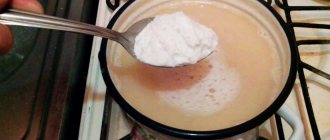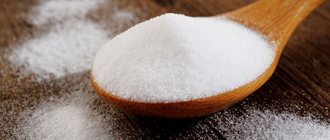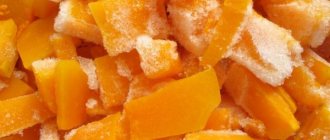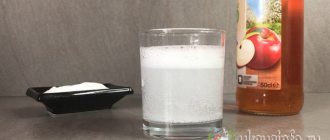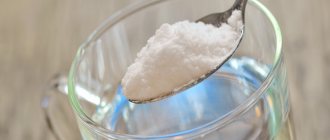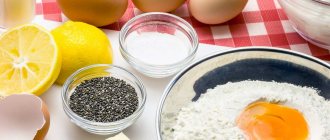Properties
The chemical properties of soap and soda make it possible to use the solution for household and cosmetic purposes, as well as in folk medicine.
Useful properties of the solution:
- Has an antiseptic, antibacterial effect.
- Copes well with pathogenic microflora, infections, fungi.
- Cleans various contaminants without destroying the structure and pigment of the material.
- In cosmetic procedures it is used to remove dead particles of the epidermis, soften the skin, and accelerate renewal processes.
- Has hypoallergenic properties.
Read more: Properties and formula of baking soda.
Wax stains
One of the best ways to get rid of wax stains on a hard surface is to melt it using a hair dryer. As the wax melts, wipe it with an absorbent napkin or cloth.
You can remove wax from carpets or various fabrics using an iron. Place newspaper on both sides of the fabric to absorb the wax as it melts from the hot iron. Change newspapers as needed.
Important: do not use a hair dryer or iron in case of flammable materials.
To remove a wax stain, sprinkle it on the face and back with tooth powder, cover it with white paper and put it under a press for a day. Then, brush off the powder with a dry, clean brush.
Drops of candle wax frozen on polished furniture are carefully removed with the tip of a table knife heated in boiling water. The mark can be wiped off. If a mark remains, wipe it off with a cloth soaked in gasoline or warm water. Sometimes, however, you end up with a matte stain that needs to be polished with furniture polish.
You can also use baking soda to remove wax.
Mix 2 tablespoons of baking soda with 2 cups of hot water. Wash the smoked areas with this mixture using a washcloth. Let dry, then rinse the surface with clean water.
If the soot cannot be washed off, make a thick paste of soda, spread it on the stains for several hours, keeping it moist (spray it with a spray bottle approximately every hour).
Note: Use this product on chemically inert surfaces such as unpainted wood, glass, or stone. It is not recommended to use washing soda paste on waxed floors (removes wax), painted wooden surfaces (soda can strip paint), or aluminum surfaces.
Ingredients
Classic solution recipes use sodium bicarbonate and laundry soap. The latter can be purchased with different percentages of acids (indicated on the bar). Laundry soap is also available in liquid form. In category 1 soap, with a content of 72%, maximum acidity and the absence of any organic odors are implied. Categories 2 and 3, 70% and 65%, use rosin and synthetic fatty acids.
Figure 1 - laundry soap of categories 1, 2 and 3.
Why is it important to disinfect toys?
Children, especially small ones, are open to attacks from all kinds of viruses and bacteria. Because they spend a lot of time on the floor, putting everything in their mouths in their mouths, and playing with various objects. Dust, microorganisms, and fungi accumulate on the latter.
To protect the child from infection, poisoning or the development of allergic reactions, all children's toys are disinfected in a timely manner. Including: for infants - twice a day, for older children - at the end of each day.
In order not to create unnecessary problems for yourself, you do not need to give your child a lot of nesting dolls, pyramids or balls. Three or four types are enough. But they can be changed often and diversify children's games.
Disinfection solution
To prepare a solution for disinfection:
- Grate 50 gr. laundry soap.
- Dissolve soap in 1 liter. hot water.
- Add 200 gr. soda, stir thoroughly.
- Dilute the finished concentrate with 9 liters of water.
- Disinfection should be carried out once a day. After treatment, it is advisable to ventilate the room.
- After treatment, wipe the surface dry.
The prepared solution is used to treat floors, tiles, plastic products, and plastic toys.
Is baking soda a disinfectant?
Before the advent of numerous detergents, housewives used soda. They washed dishes and surfaces with it, and boiled things in the solution to get rid of greasy stains and odors. Many modern cleaning powders and gels contain sodium bicarbonate (soda) as a base.
Baking soda disinfects objects due to its alkaline environment. Under such conditions, many microorganisms die. There are different types of compounds that differ in chemical composition.
Caustic soda is an aggressive caustic soda; when used for disinfection, it is important to follow the instructions for use:
- For home – 1 g of dry caustic powder and 100 ml of water or 2 ml of liquid caustic soda solution per 100 ml of water.
- Preventive treatment of livestock buildings and farmsteads - a 4% concentration is needed, i.e. 40 g of powder per 1 liter of water or 80 ml of liquid form for the same volume of water.
- If a sick animal is detected, the concentration increases to 5–10%, depending on the causative agent of the pathology.
Caustic is an excellent disinfectant. It is diluted in a plastic container. Unused remains are stored in tightly closed containers out of direct sunlight.
A milder disinfectant is soda ash. Consists of sodium carbonate. Suitable for cleaning dishes, clearing blockages in pipes, washing clothes, disinfecting surfaces. Disinfects and cleans well. To obtain a working solution, 3 tbsp. l. powder is diluted in 1 liter of water.
The most common baking soda is sodium hydrocarbonate or sodium bicarbonate, suitable for cleaning dishes and leaving baked goods. The substance is safe, non-toxic, dissolves well in warm or hot water, is easily washed off, and disinfects.
Will soda destroy coronavirus (scientific evidence):
Dishwashing solution
To make the solution in a stainless steel or enamel bowl (Figure 2), follow the following recipe:
- grate a whole bar of soap 72% (100 g)
- add it to 2 liters of boiling water;
- then remove from heat. Pour 6 tbsp into the still warm liquid. spoons of sodium bicarbonate;
- mix thoroughly. Pour the prepared solution into a tightly sealed jar.
To clean a 5 liter pan, just 1 tbsp will be enough. spoons of detergent.
Figure 2 - preparing a soap-soda solution in an enamel pan.
To make a solution in a ceramic or glass container, use the following recipe:
- For 500 ml of water, take 30 ml of liquid laundry soap, 2 tbsp. spoons of soda and 1 tbsp. a spoonful of mustard powder;
- Mix all ingredients. Pour the product into an empty dispenser bottle;
- Shake well until foam appears.
The video describes how to quickly prepare safe dishwashing detergent. A product made at home also allows you to reduce the cost of household chemicals.
Using soap and soda solution at home
Soda ash is a natural antiseptic that destroys many types of pathogens.
The composition includes 3 main components:
- soda, which has disinfecting and antiviral effects and has an abrasive structure, which allows you to remove stains from various surfaces;
- red soap (65%, 72%), consisting of a large amount of fats that have antimicrobial and cleansing effects;
- water, which serves as a solvent in this case.
Soda is used for whitening, removing stains and disinfecting at home, schools, kindergartens, hospitals and other institutions in the following cases:
- for washing all items in the apartment and house, other rooms, cleaning tiles in the bathroom and kitchen;
- skin peeling;
- processing vegetables and fruits before use.
The product has no adverse reactions because it is based on natural ingredients. When using, it is important to rinse thoroughly with water, because soap and soda leave stains and streaks.
Preparing a soap-soda solution for disinfection
A 1% solution is used to disinfect floor coverings, surfaces, and antibacterial treatment of walls in clinics, schools, or for washing toys. If the premises are dirty, it is better to increase the concentration of active components in order to effectively remove all stains. To prepare a soap-soda solution for disinfection, it is first recommended to determine the concentration.
You will need 20 liters of warm water, 0.2 kg of soda and the same amount of red acid soap. The 72% product is recommended because it contains a high amount of fatty acids, making it more effective at cleaning dirt and eliminating germs.
To obtain a two percent soda solution, take 0.2 kg of ingredients and fill the container with 10 liters of water. The soap must first be crushed. A blender or grater is used for this.
To eliminate pathogens, you need to soak all items in a soapy solution for half an hour. To disinfect walls, furniture or plumbing, you need to wash everything with a sponge and solution. After this, rinse well with clean water. When working, you need to use gloves so as not to dry out or damage the skin of your hands.
Soap and soda solution in kindergarten according to SanPin
The composition is needed for antibacterial cleaning of desks, beds, and disinfection of toys. Sometimes a combination of soda and soap is used for washing, as it works well with all types of stains and gives products freshness. Whiteness is sometimes used for the same purposes, but it causes allergies, and soda and soap are a harmless composition. A soap-soda solution in kindergarten is necessary in the following cases:
- A 2% solution is used for daily treatment of the premises twice a day - in the morning and at lunchtime, while children are sleeping or walking outside;
- Daily floor cleaning is carried out with a 1% solution.
Cleaning of plumbing fixtures, toilets, bathtubs, and daily treatment of pots is done with powder disinfectants or bleach. The procedure is carried out in the evening after the institution closes.
The product must be mixed before cleaning and used immediately. The composition cannot be stored for a long time and due to chemical reactions it acquires a slippery consistency. Baking soda is better for cleaning. It has long been used in the household as a cleansing and disinfectant component.
Soap and soda solution for washing dishes is prepared at a concentration of 1%. Instead, according to sanitary rules, a ready-made detergent composition designed specifically for children, for example, Eared Nyan, is allowed. But such products are used more often in private and paid establishments, and government agencies use soda to disinfect and remove stains.
Soap and soda solution for washing dishes
To obtain the product you will need the following ingredients:
- 100 g laundry soap 72%;
- 2 liters of water;
- 5 tbsp. l. baking soda.
To get a gel-like mass, you need to grate the soap and dissolve it in warm water until a homogeneous consistency is obtained. Then add baking soda and stir thoroughly again. The product is abrasive and is used to clean tiles, microwaves, ovens, pots and pans. It is recommended to store the remaining gel in a container with a tight-fitting lid.
After washing, the dishes must be rinsed well with running water, as soap can cause an allergic reaction or poisoning.
The resulting combined gel is used for washing children's clothing. Before pouring the product into the washing machine, you need to dilute it with boiling water. Double rinsing is recommended because baking soda may remain in the folds of clothing.
Using soap and soda solution for medicinal purposes
Soap and soda baths are used in folk medicine and home cosmetology due to their antiseptic properties. Laundry soap consists of fatty acids that kill germs, slightly dry out the upper layer of the epidermis and promote wound healing. Thanks to these properties of the components, the solution is used for home treatment. There are several recipes based on it.
Preparation of soap-soda solution:
- 1 tbsp. l. baking soda is mixed in 50 g of warm water;
- 50 g of soap is ground on a grater and added to water with soda, mixed.
The resulting composition is used for washing and compresses of the extremities in the presence of fungal skin diseases. It can also be added to water while bathing to soften the skin, heal wounds, and even enhance the immune system and protective functions of the body.
When treating mycoses and onychomycosis, after a bath you need to use pumice to remove keratinized skin. Then you need to apply an antifungal cream or ointment prescribed by your doctor.
If you steam your feet in a combination of these products, you can get rid of corns and calluses forever. This is especially true for women who like to walk in heels, or people who constantly wear hard, closed shoes (for example, military personnel in combat boots).
Soda-soap solution for treating walls
Most often, walls are treated in canteens, hospitals, schools and other crowded places where constant harmless disinfection is necessary. The product can consist only of water and soap or soda. The percentage of products is selected depending on the degree of contamination. For daily wet cleaning of surfaces, the following composition is used:
- 25 g soda;
- 50 g soap;
- 5 liters of water.
A low concentration is enough to remove dust and germs from the walls. Can be used on any surface except paper wallpaper and decorative plaster. Use soda to clean wallpaper, because... it effectively cleans all types of dirt and deposits.
Fungus treatment
A soap-soda solution is used at the early stage of the disease. The product allows you to get rid of unpleasant odor, itching and flaking, and restore the integrity of the skin.
Solution recipe:
- Pour 3-6 liters of water into a clean basin, add 20 g. soap shavings or the same amount of liquid laundry soap;
- add 30 gr. soda You can use 4-5 drops of tea tree oil to enhance the healing effect;
- Immerse your feet or hands in the bath.
For sensitive skin, use category III laundry soap (64%).
The procedure lasts 10 minutes. This should be repeated every evening after basic hygiene procedures. Treatment will take from several weeks to 6 months, depending on the area of the lesion.
Read more: Foot baths with soda for fungus.
Dry cleaning
These methods do not involve the use of water. Any contact with water is prohibited, as if you wash it, you can damage the soft toy or leave stains on it.
Soda for stains
Baking soda is known for its cleansing and neutralizing properties. Using this method will help wash the toy and kill any germs contained in it. No water is required with this method.
To clean with soda you will need: a brush, 100 grams of soda, a garbage bag, a cotton towel.
Wash
A soap-soda solution is well suited for removing stains of any complexity. Its main advantage is hypoallergenicity. The solution is suitable for washing clothes for babies and people with skin diseases. It can be used for any items, including delicate items made of silk and wool.
Recipe for soap and soda solution for washing:
- 10 gr. stir soda in 50 ml of warm water;
- add 40 gr. grated soap;
- After stirring well, add the product to the water.
The volume of the prepared product is enough to wash 3-4 kg of clothes.
Labels
Plastic containers are very convenient and practical. Their only drawback is that the stickers are difficult to remove. Most adhesives are ineffective for plastic, so very strong compounds are used to glue labels to plastic. To get rid of them, it is not enough to soak the plastic in hot water, as it works with glass surfaces. If you try to peel them off, you can scratch the plastic. Glue residue sticks to your hands and collects dirt.
However, there is a way out. Spread the label with vegetable oil. Leave it for a day. After you remove the label, partially dissolved adhesive may remain on the surface of the plastic. To get rid of it, apply oil to the area and leave it overnight. Wipe off any oil or adhesive residue and wash the plastic item in hot, soapy water.
SANPIN rules
The sanitary and epidemiological standards developed for preschool institutions, hospitals, and clinics provide instructions for the preparation and use of the solution.
Use of the product according to SanPiN:
- in preschool institutions, a 2% solution is used twice a day to treat toys, clean surfaces, carry out wet cleaning, and clean furniture;
- in inpatient departments and clinics, soap and soda solution is used for daily and general cleaning of premises and equipment;
- according to the instructions, a 1% solution is used for cleaning floors; a 2% solution is used for treating toys and furniture in kindergartens;
- For general cleaning, regardless of the purpose of the room, only a 2% solution is used.
How to make a soap and soda solution for cleaning?
You need to dissolve 50 g of crushed soap 65% or 72% (you can use soap with a whitening effect “Friend”) and soda in 5 liters of warm water. The resulting liquid is used to treat walls and floors; a White solution is recommended for washing floors to enhance disinfection if there are no children or animals in the house. If the proportions differ from the recommended recipe, it’s okay.
During general cleaning, the concentration can be increased to 1%, in order to eliminate stains in addition to disinfection, a 2% mixture is used:
- 5 liters of water;
- 100 g soap shavings;
- 100 g baking soda.
This concentration is suitable for cleaning dirty floors, cleaning school desks painted with ballpoint pens and markers.
When using a soap solution, surfaces should be wiped with a clean, damp cloth, because soap tends to leave marks, just as baking soda leaves marks.
Precautionary measures
Rules for the safe use of soap and soda solution.
- To clean various surfaces, wash, and handle toys, be sure to wear rubber gloves;
- after cosmetic baths, you need to rinse your feet and hands under running water, wipe dry and apply cream;
- processed fruits, vegetables, toys should also be thoroughly rinsed with water and dried with a towel.
Soap and soda solution continues to be a leader among household cleaners and disinfectants. This is a universal tool for solving many problems and significant budget savings.
Disinfection of toys in medical institutions
In medical institutions, as well as in preschool institutions, only products made of rubber, plastic and wood can be used. In health care facilities, toys must be disinfected daily. Disinfection is carried out as follows: the products are immersed in a container filled with a disinfectant solution. At the end of the disinfection holding time, remove from the solution, rinse thoroughly with running water and dry.
To disinfect toys, it is necessary to use effective disinfectants with a broad spectrum of antimicrobial action. At the same time, the disinfectant used should not be toxic. These properties are fully met by the Septolite Plus disinfectant.
Tablecloth
Stains on an oilcloth tablecloth can be easily removed with a solution of milk and water (1:1), and then wiped with a dry cloth.
Beer and white wine stains on a fabric tablecloth can be removed with vodka and a sponge. Red wine is covered with salt and washed with water. It is often very effective to pour hot water over the stain, first stretching the tablecloth over the basin.
Fruit stains can be removed with hot water or hot milk. Wipe the old stain with a solution of citric acid (2 g per glass of water), then rinse thoroughly with warm water.
Coffee stains? 5% salt solution in plain water. But tea stains will have to be removed with glycerin and ammonia (4:1).
Paraffin stains must first be very carefully scraped off with a knife, maybe slightly heated, and then covered with paper and ironed with a hot iron.
Wipe off a small stain from a ballpoint pen on oilcloth or plastic with the head of a match slightly moistened in water.
If the thermometer breaks
This happens periodically in every family. The phenomenon is not very pleasant, but the main thing is to get rid of the consequences, namely poisonous mercury, as quickly as possible. A soap-soda solution for disinfection in this case is ideal. Of course, if the city has a special service for neutralizing hazardous waste, then entrust it with it.
The first step is to fence off the place where the thermometer was broken. Try to find where the mercury balls rolled out. Do not rush to open the windows; a draft can cause it to fly apart into thousands of tiny particles. If the balls are clearly visible, then collect them using napkins. Be sure to wear gloves before working.
To neutralize everything, down to the smallest particles, you need to carry out disinfection. To do this, the entire area where the mercury was spilled must be treated with a soap-soda solution. It should be quite strong, 30 g of soda and 40 g of soap per 1 liter of water. Cover all surfaces that are located near the damage to the thermometer with the solution. This applies to wooden and metal surfaces. Don't rush to wash it off. To complete the neutralization reaction, you need to wait two days. Now the solution can be washed off with cool water.
Baking soda is an odor fighter
Unpleasant odors are a clear sign of something “bad”. As a rule, they are a consequence of the activity of microorganisms. Few people are happy with this state of affairs. But the disinfecting properties of soda will help here too.
We'll have to go back to carpets and animals again. Pets - cats and dogs - can be thoroughly washed using a soda solution. To prepare it, two or three teaspoons of soda should be stirred in a liter of water. The animal must be carefully sprayed with the solution and combed. After this treatment the animal looks much fresher.
Baking soda can be used as a dry carpet deodorizer. To prepare the product you will need one pack of soda and 10-15 drops of aromatic oil. All this is thoroughly mixed. The carpet or covering is generously sprinkled with the prepared mixture and left for two to three hours. Next, the surface is treated with a stiff brush and vacuumed. Such cleaning will not only eliminate odors left by animals, but will also get rid of stuck fur and other contaminants, and the pleasant aroma will last for several days.
